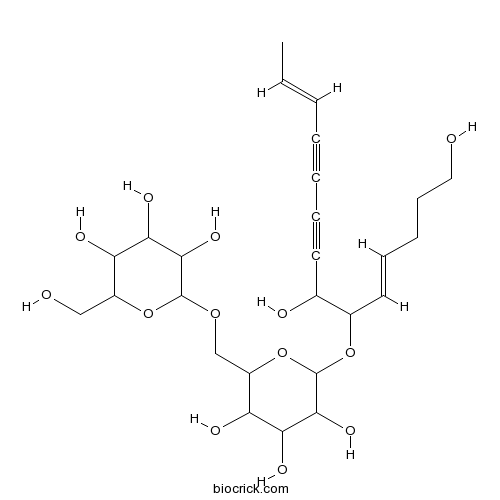LobetyolininCAS# 142451-48-7 |

Quality Control & MSDS
3D structure
Package In Stock
Number of papers citing our products

| Cas No. | 142451-48-7 | SDF | Download SDF |
| PubChem ID | 5459227 | Appearance | Powder |
| Formula | C26H38O13 | M.Wt | 558.6 |
| Type of Compound | Miscellaneous | Storage | Desiccate at -20°C |
| Solubility | Soluble in Chloroform,Dichloromethane,Ethyl Acetate,DMSO,Acetone,etc. | ||
| Chemical Name | 2-[[6-[(4E,12E)-1,7-dihydroxytetradeca-4,12-dien-8,10-diyn-6-yl]oxy-3,4,5-trihydroxyoxan-2-yl]methoxy]-6-(hydroxymethyl)oxane-3,4,5-triol | ||
| SMILES | CC=CC#CC#CC(C(C=CCCCO)OC1C(C(C(C(O1)COC2C(C(C(C(O2)CO)O)O)O)O)O)O)O | ||
| Standard InChIKey | GDLSOFWVVAOUJI-FWTOVJONSA-N | ||
| Standard InChI | InChI=1S/C26H38O13/c1-2-3-4-5-7-10-15(29)16(11-8-6-9-12-27)37-26-24(35)22(33)20(31)18(39-26)14-36-25-23(34)21(32)19(30)17(13-28)38-25/h2-3,8,11,15-35H,6,9,12-14H2,1H3/b3-2+,11-8+ | ||
| General tips | For obtaining a higher solubility , please warm the tube at 37 ℃ and shake it in the ultrasonic bath for a while.Stock solution can be stored below -20℃ for several months. We recommend that you prepare and use the solution on the same day. However, if the test schedule requires, the stock solutions can be prepared in advance, and the stock solution must be sealed and stored below -20℃. In general, the stock solution can be kept for several months. Before use, we recommend that you leave the vial at room temperature for at least an hour before opening it. |
||
| About Packaging | 1. The packaging of the product may be reversed during transportation, cause the high purity compounds to adhere to the neck or cap of the vial.Take the vail out of its packaging and shake gently until the compounds fall to the bottom of the vial. 2. For liquid products, please centrifuge at 500xg to gather the liquid to the bottom of the vial. 3. Try to avoid loss or contamination during the experiment. |
||
| Shipping Condition | Packaging according to customer requirements(5mg, 10mg, 20mg and more). Ship via FedEx, DHL, UPS, EMS or other couriers with RT, or blue ice upon request. | ||
| Description | 1. Lobetyolinin exhibits DPPH radical scavenging activity. |

Lobetyolinin Dilution Calculator

Lobetyolinin Molarity Calculator
| 1 mg | 5 mg | 10 mg | 20 mg | 25 mg | |
| 1 mM | 1.7902 mL | 8.9509 mL | 17.9019 mL | 35.8038 mL | 44.7547 mL |
| 5 mM | 0.358 mL | 1.7902 mL | 3.5804 mL | 7.1608 mL | 8.9509 mL |
| 10 mM | 0.179 mL | 0.8951 mL | 1.7902 mL | 3.5804 mL | 4.4755 mL |
| 50 mM | 0.0358 mL | 0.179 mL | 0.358 mL | 0.7161 mL | 0.8951 mL |
| 100 mM | 0.0179 mL | 0.0895 mL | 0.179 mL | 0.358 mL | 0.4475 mL |
| * Note: If you are in the process of experiment, it's necessary to make the dilution ratios of the samples. The dilution data above is only for reference. Normally, it's can get a better solubility within lower of Concentrations. | |||||

Calcutta University

University of Minnesota

University of Maryland School of Medicine

University of Illinois at Chicago

The Ohio State University

University of Zurich

Harvard University

Colorado State University

Auburn University

Yale University

Worcester Polytechnic Institute

Washington State University

Stanford University

University of Leipzig

Universidade da Beira Interior

The Institute of Cancer Research

Heidelberg University

University of Amsterdam

University of Auckland

TsingHua University

The University of Michigan

Miami University

DRURY University

Jilin University

Fudan University

Wuhan University

Sun Yat-sen University

Universite de Paris

Deemed University

Auckland University

The University of Tokyo

Korea University
- Myricetin 3-O-beta-D-xylopyranosyl(1-2)-beta-D-glucopyranoside
Catalog No.:BCN8140
CAS No.:142449-93-2
- NHS-SS-Biotin
Catalog No.:BCC3581
CAS No.:142439-92-7
- Crovatin
Catalog No.:BCN2517
CAS No.:142409-09-4
- Mesterolone
Catalog No.:BCC9023
CAS No.:1424-00-6
- Didemethylpseudoaspidin AA
Catalog No.:BCN3777
CAS No.:142382-28-3
- 7alpha-Hydroxy-4,11-cadinadiene-3,8-dione
Catalog No.:BCN7057
CAS No.:1423809-64-6
- FR 139317
Catalog No.:BCC5733
CAS No.:142375-60-8
- SP2509
Catalog No.:BCC5578
CAS No.:1423715-09-6
- H-D-Phe-pNA
Catalog No.:BCC3015
CAS No.:14235-18-8
- Adefovir Dipivoxil
Catalog No.:BCC5025
CAS No.:142340-99-6
- L-701,324
Catalog No.:BCC6842
CAS No.:142326-59-8
- Teuvincenone H
Catalog No.:BCN6227
CAS No.:142299-73-8
- Amthamine dihydrobromide
Catalog No.:BCC6744
CAS No.:142457-00-9
- 3-O-beta-D-apiofuranosyl(1-2)-beta-D-glucopyranosyl rhamnocitrin 4-O-beta-D-glucopyranoside
Catalog No.:BCN8141
CAS No.:142473-99-2
- Glyasperin A
Catalog No.:BCN6228
CAS No.:142474-52-0
- 19-Nortestosterone acetate
Catalog No.:BCC8445
CAS No.:1425-10-1
- MK-5172 sodium salt
Catalog No.:BCC1765
CAS No.:1425038-27-2
- L-690,488
Catalog No.:BCC5667
CAS No.:142523-14-6
- L-690,330
Catalog No.:BCC5666
CAS No.:142523-38-4
- 1,2,3,4,7-Pentamethoxy-9H-xanthen-9-one
Catalog No.:BCN1570
CAS No.:14254-96-7
- Cimidahurinine
Catalog No.:BCN6229
CAS No.:142542-89-0
- Sageone
Catalog No.:BCN3144
CAS No.:142546-15-4
- A 484954
Catalog No.:BCC6203
CAS No.:142557-61-7
- Glyasperin D
Catalog No.:BCN6836
CAS No.:142561-10-2
Quality evaluation of medicinally-used Codonopsis species and Codonopsis Radix based on the contents of pyrrolidine alkaloids, phenylpropanoid and polyacetylenes.[Pubmed:24203345]
J Nat Med. 2014 Apr;68(2):326-39.
A comparative study of 56 specimens of three medicinally-used Codonopsis taxa collected from China and 54 commercial samples of Codonopsis Radix available in Chinese, Japanese and Korean markets was carried out by quantitative analysis of seven major components: codonopyrrolidium B (1), codonopyrrolidium A (2), tangshenoside I (3), cordifolioidyne B (4), Lobetyolinin (5), lobetyolin (6) and lobetyol (7). The quantitative results, based on a well-established HPLC-DAD method, indicated that the contents of these seven compounds varied considerably among the samples, not only inter-species but also intra-species. C. pilosula and C. pilosula var. modesta showed similar chemical compositions, while C. tangshen differed considerably from these two in chemical composition. The results of principal component analysis (PCA) indicated that two main groups were classified; one group mainly included C. pilosula, C. pilosula var. modesta and the commercial samples derived from these two taxa, while the other group was composed of C. tangshen and its derived commercial samples. Compound 1 was the main component in the roots of C. pilosula and C. pilosula var. modesta, while 3 and 2 had relatively high contents in the roots of C. tangshen. Therefore, 3, 2 and 1 could be chemical markers to differentiate C. tangshen from C. pilosula and C. pilosula var. modesta.


